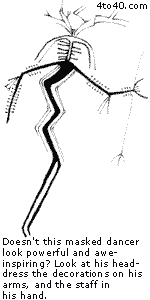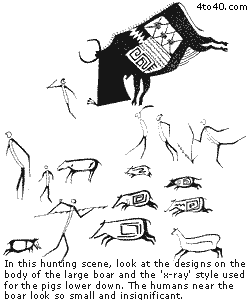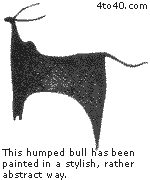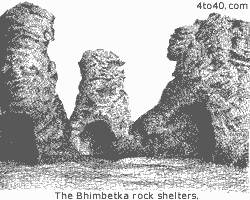 Bhimbetka was a great place to live for stone age
people. The overhanging rock ledges on the hillsides gave them shelter. The
thick forest was full of edible plants and fruits that they could collect and
many different kinds of animals that they could hunt. Water was available all
year round in the streams and creeks.
Bhimbetka was a great place to live for stone age
people. The overhanging rock ledges on the hillsides gave them shelter. The
thick forest was full of edible plants and fruits that they could collect and
many different kinds of animals that they could hunt. Water was available all
year round in the streams and creeks.Thousands of stone tools belonging different phases of the stone age have been found at Bhimbetka. The palaeolithic age was the first part of the stone age, when people got their food through hunting and gathering. The palaeolithic people who lived in the rock shelters of Bhimbetka sometimes paved the floors with stone boulders and slabs. They buried their dead under the floors along with tools made of stone and bone This show that they had some sort of belief in life after death. Although some kinds of rock for making stone tools were available in the Bhimbetka hills, people sometimes traveled long distances to get certain special kinds of stones.
Bhimbetka is like a gigantic open air art gallery where you can see pictures made by people over thousands of years. Out of the 642 rock shelters at Bhimbetka, nearly 400 have paintings. The oldest and largest number of paintings belong to the mesolithic phase, of the stone age. They may be about 10,000 years old. During the mesolithic phase, people were still basically hunters and food gatherers. But they had learnt to make and use tiny stone tools known as microliths. They attached these onto bone or wooden handles to make knives, arrows, spears and other kinds of weapons and tools.
 The stone age artists made their paintings on the
surfaces, walls and ceilings of the rock shelters. Some of the paintings were
made in shelters where people lived. But some of the biggest and best paintings
were made in places which do not seem to have been living spaces at all. Maybe
these were places where some sort of secret magic or religious rituals were
performed. Some of the most grand paintings are very high up on rock surfaces or
close to the ceilings of rock shelters. The artists and their helpers could only
have climbed to these spots with the help of scaffolding. Such paintings must
have had a special importance for the people. But than, many others may have
been made by people simply because they liked to paint or because they wanted to
make their homes more colorful and beautiful, or because they wanted to tell a
story in pictures. Like us, stone age people also had feelings, thoughts,
worries, fears, likes and dislikes. And they expressed these things in their
paintings.
The stone age artists made their paintings on the
surfaces, walls and ceilings of the rock shelters. Some of the paintings were
made in shelters where people lived. But some of the biggest and best paintings
were made in places which do not seem to have been living spaces at all. Maybe
these were places where some sort of secret magic or religious rituals were
performed. Some of the most grand paintings are very high up on rock surfaces or
close to the ceilings of rock shelters. The artists and their helpers could only
have climbed to these spots with the help of scaffolding. Such paintings must
have had a special importance for the people. But than, many others may have
been made by people simply because they liked to paint or because they wanted to
make their homes more colorful and beautiful, or because they wanted to tell a
story in pictures. Like us, stone age people also had feelings, thoughts,
worries, fears, likes and dislikes. And they expressed these things in their
paintings.What did the stone age people use for brushes and paints? They could have made the handles of brushes out of twigs or wood. For the brush itself, they could have used silk cotton, animal fur or squirrel tail. The mesolithic artists of Bhimbetka knew as many as 21 colours, including various shades of white, yellow, orange, red, purple, brown, green and black. Their favourite colours were white and light red. The paints were made by grinding various rocks and minerals. They got red from haematite (iron oxide, known as 'geru' in India). The green came from a green variety of a stone called chalcedony. White might have been made out of limestone. The rock of mineral was first ground into a powder. This may then have been mixed with water and also with some thick or sticky substance such as animal fat or gum or resin from trees.
 The mesolithic artists loved to paint animals.
They painted deer, boars, elephants, leopards, tigers, panthers, rhinoceroses,
antelopes, fish, frogs, lizards, squirrels and birds. It is interesting that
they did not make any paintings of snakes. Maybe this was because they were very
afraid of them. In some pictures, animals are chasing men. In others they are
being chased and hunted by men. The paintings may look simple, but if you look
at them carefully, you will see that the artists were able to convey movement
and feeling very skillfully.
The mesolithic artists loved to paint animals.
They painted deer, boars, elephants, leopards, tigers, panthers, rhinoceroses,
antelopes, fish, frogs, lizards, squirrels and birds. It is interesting that
they did not make any paintings of snakes. Maybe this was because they were very
afraid of them. In some pictures, animals are chasing men. In others they are
being chased and hunted by men. The paintings may look simple, but if you look
at them carefully, you will see that the artists were able to convey movement
and feeling very skillfully.The hunting scenes show people hunting in groups, armed with sticks, spears, bows and arrows and slings. They also used traps and snares to catch animals. The hunters wear simple clothes and ornaments. They are sometimes shown wearing masks and head-dresses crowned with feathers, horns or antlers. The animals are painted in a very realistic way. They usually look huge and powerful compared to the humans who look small and insignificant. Sometimes, animals were painted in the 'x-ray style,' showing their inner organs. This gives us the feeling that we are looking into the animal, just as an x-ray gives us a picture of the skeleton inside our body. Some of the animal pictures, especially in the hunting scenes, show a fear of animals, but many others show a feeling of tenderness and love for them. This feeling comes out in scenes of grazing buffaloes, hopping rabbits, and monkeys jumping about, and also in scenes that show animals like panthers, tigers and deer with their babies.
 While the artists made the pictures of animals in
great detail, they usually painted men as match-stick figures, and women with
only a slightly fuller body. They painted young and old people. They painted
children running, jumping and playing. They painted scenes of people dancing
gracefully in groups, sometimes to the beat of a drummer. They painted scenes of
people gathering fruit or honey from trees, and of women grinding and preparing
food. Some of the scenes of men, women and children seem to show a sort of
family life. Certain men, with masks or designs on their body, often carrying
baskets on their back, look like chiefs. There are others, wearing masks and
animal head-dresses, who seem to have been priests. In many of the rock shelters
we see hand-prints, fist-prints, and dots made by fingers tips. Even today, in
many parts of our country, people make these kinds of prints on the walls of
their houses on special occasions.
While the artists made the pictures of animals in
great detail, they usually painted men as match-stick figures, and women with
only a slightly fuller body. They painted young and old people. They painted
children running, jumping and playing. They painted scenes of people dancing
gracefully in groups, sometimes to the beat of a drummer. They painted scenes of
people gathering fruit or honey from trees, and of women grinding and preparing
food. Some of the scenes of men, women and children seem to show a sort of
family life. Certain men, with masks or designs on their body, often carrying
baskets on their back, look like chiefs. There are others, wearing masks and
animal head-dresses, who seem to have been priests. In many of the rock shelters
we see hand-prints, fist-prints, and dots made by fingers tips. Even today, in
many parts of our country, people make these kinds of prints on the walls of
their houses on special occasions.One of the curious things about the paintings at many rock art sites is that the artists often painted new paintings on top of the older ones. At Bhimbetka, in some places there are as many as 20 layers of paintings, one on top of other. Why did the artists paint in the same spot when so much empty space was available? We don't know for sure, but may be this was because some of the paintings and places were considered sacred or special. The hunting scenes could have been connected with some sort of ritual that people performed in the hope that it would lead to a successful hunt.
 The later paintings at Bhimbetka have been
different themes and styles. Instead of men hunting in groups. we see men
hunting alone. There are men on horses and chariots, tamed animals and
processions of animals. The still later paintings show soldiers marching or
facing each other in battle, and royal processions. Animals become much less
important. These must have been the things that the people who lived in the rock
shelters of Bhimbetka either experienced themselves or saw happening in the
plains below the hills. Just as the paintings made by stone age people tell us
about the way of life of stone age humans, these later paintings show us how
much life had changed since those early times.
The later paintings at Bhimbetka have been
different themes and styles. Instead of men hunting in groups. we see men
hunting alone. There are men on horses and chariots, tamed animals and
processions of animals. The still later paintings show soldiers marching or
facing each other in battle, and royal processions. Animals become much less
important. These must have been the things that the people who lived in the rock
shelters of Bhimbetka either experienced themselves or saw happening in the
plains below the hills. Just as the paintings made by stone age people tell us
about the way of life of stone age humans, these later paintings show us how
much life had changed since those early times.